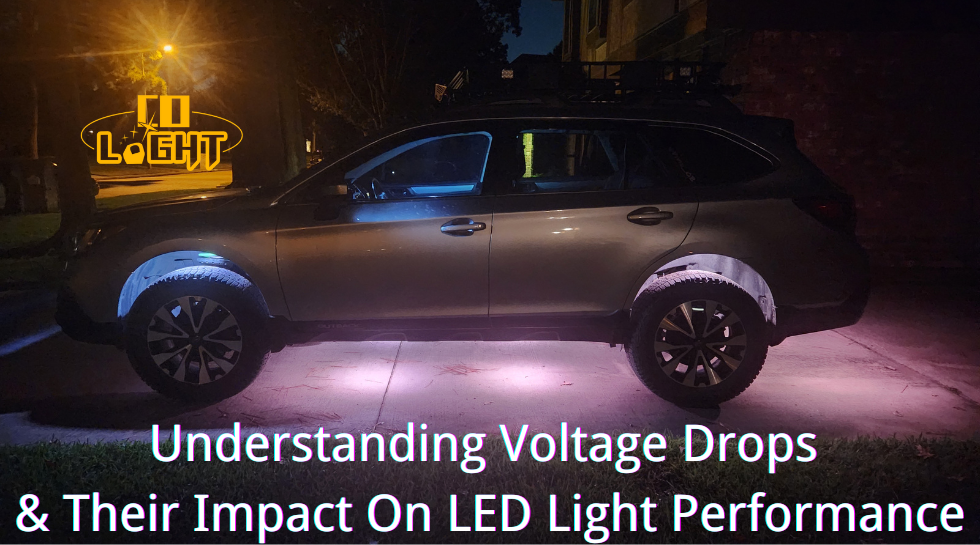When setting up a lighting system with multiple LED pods, particularly in vehicles or other custom applications, voltage drop is a key factor that can significantly affect performance. If you’ve ever noticed your bright white LEDs losing their intensity or even changing color, while other colors remain unaffected, voltage drop could be the underlying issue.
What is Voltage Drop?
Voltage drop refers to the reduction in voltage as electrical current travels through a wire. In simpler terms, the further the electricity has to travel, the more power it loses along the way. This can result in inconsistent performance, especially when multiple light sources are connected over a distance.
In an ideal setup, the voltage should remain stable across all connections. However, when the power supply has to deliver electricity to numerous pods simultaneously—such as RGB Rock Lights has 12 LED pods, each connected by a 3 meter extension cord—the further you get from the power source, the greater the chance for voltage drop to occur.
Why White Light is Most Affected?
In a multi-color LED system, white light typically requires the most power to achieve maximum brightness. This is because white light is often produced by combining red, green, and blue (RGB) LED diodes at full capacity, or by using separate high-power white LED diodes. When voltage drops below optimal levels, these diodes can’t receive the necessary current to produce full brightness. As a result, the white light appears dimmer or may even shift in color, whereas other colors (which require less power) may not be as affected.
The Impact of Voltage on Light Output
For high-powered LEDs, maintaining a stable voltage is crucial for consistent performance. Ideally, your power source should provide between 13V to 13.5V to ensure all pods receive enough current to operate at full capacity. If the voltage falls below this range, especially at the farther ends of the circuit, the brightness of the LEDs will decrease, resulting in inconsistent light output across the system. Conversely, exceeding 14V can also cause issues, potentially leading to overheating or damage to the LEDs.
How to Solve Voltage Drop Issues
If you're experiencing a significant voltage drop in your LED setup, here are a few steps you can take to mitigate the issue:
- Optimize the Power Source Location: Instead of drawing power from a weak or distant connection point, try connecting the power source as close to the LED pods as possible. This will minimize the distance electricity needs to travel, reducing the chances of voltage drop.
- Use a Stable Voltage Supply: Ensure that your power supply consistently provides between 13V to 13.5V. This range is optimal for most LED systems. Avoid exceeding 14V to prevent potential damage to the lights.
- Upgrade Wiring and Connectors: If voltage drop continues to be an issue, consider using thicker wiring or higher-quality connectors. This will reduce resistance and help maintain a more consistent voltage across all connections.
- Use Shorter Extension Cables: Longer cables introduce more resistance, which exacerbates voltage drop. If possible, reduce the length of the extension cords between the power source and the LED pods.
Understanding voltage drop and its impact on LED performance is critical for maintaining the brightness and color integrity of your lighting system. White LEDs, in particular, are more sensitive to voltage inconsistencies, which is why they tend to show more noticeable changes in brightness and color when voltage drops below optimal levels. By optimizing your power setup and ensuring a stable voltage supply, you can avoid these issues and enjoy consistent, bright lighting across all your LED pods.
By following the best practices outlined above, you'll be able to maintain a reliable and efficient lighting system that performs well under all conditions.


